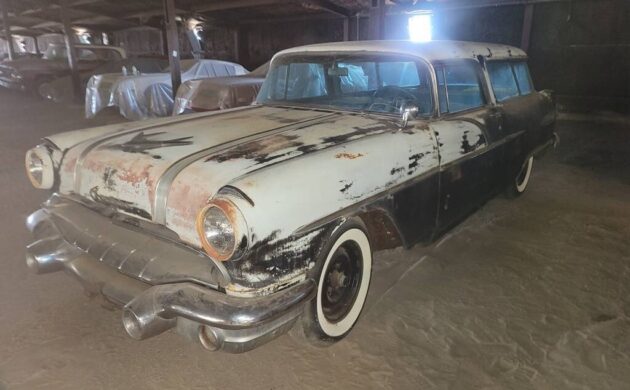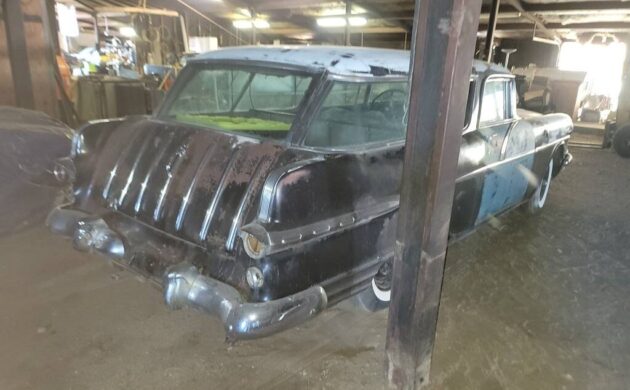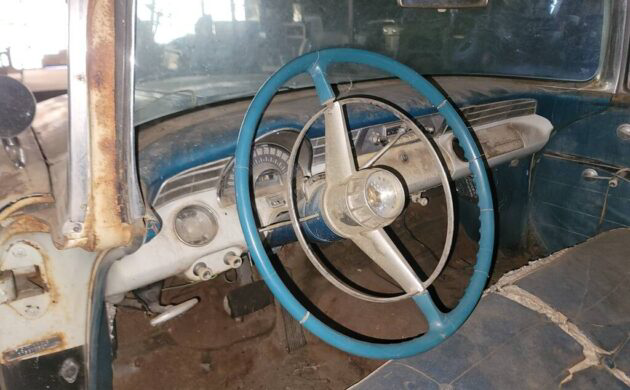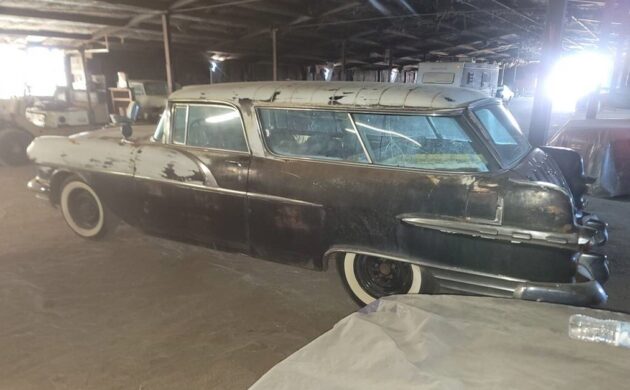The 1955-57 Chevrolet Bel Air Nomad, a 2-door sport wagon, was a halo car for the GM division. Of the “Tri-Five” Chevies, the Nomad is the most collectible today. But many people forget that Pontiac had their own version of the wagon called the Custom Safari, part of the Star Chief series. They turn up less often than the Nomads as less than half as many were built. This ’56 edition looks to have been squirreled away for years in a dark warehouse along with some other vintage automobiles. Located in Aurora, Colorado, this aged Poncho is available here on craigslist for $18,500. Another cool tip from Gunter Kramer.
In 1954, Chevrolet displayed a Motorama concept car based on the new Corvette. It led to the development of the Nomad when the A-bodies were redesigned in 1955. To decrease tooling and production costs and increase sales potential, the design was shifted to the full-size Chevy chassis. And to help decrease production costs, the Pontiac Safari was created to share the design. For whatever reason, the Safari was less popular than the Nomad, which wasn’t a big seller either. Just 9,094 A-body Safaris were assembled compared to 22,375 Nomads. Both divisions would move on from the sport wagon concept in 1958.
As the Nomad was based on the Bel Air, the Safari was part of the Star Chief line-up. Yet, the front clip was shared with the Chieftain, while the body from the cowl back was unique. In its three model years, the Safari would offer a different V8 each outing, with 1956 being a 317 cubic inch motor (up from 287 CI). The seller’s version has the 3-speed Strato-Flight Hydra-Matic transmission. For 1956, the Safari got a minor styling update, just as did the Nomad. Two-tone paint would be standard for the Safari, with the seller’s wagon sporting white over black.
Little is known about the seller’s Safari, though we’re told it’s been in hibernation since 2010. It’s a complete car with a clear title, so no huge restoration obstacles should be at hand. The engine and transmission are said to be original, though the wagon has not run in 13 years. All the brightwork exists except for one Safari emblem; but just in case, the seller has some extra chrome pieces to come along for the ride. Rust is present in the body and floorboards and the interior is in rough condition from lack of attention. Also, one of the doors is blue, indicating it was replaced for some reason. For fans of these low-production sport wagons, which do you prefer, the Nomad or the Safari?






Neat old wagon. Think the transmission is a 4 speed hydramatic. Great writeup as always.
Never understood why someone hasn’t built a Safari with a big Poncho under the hood resto mod style. The Chevy version pretty much got all the love. Great looking cars!
This is one cool car! She needs a LOT work to get it safely on the road though. If I had tons of cash to throw at something I’d pick this up. 2 door wagons if fact all wagons rock! Wonder what the seller means by floor rust or is it rot.Under car pics would be nice.
Given the dk. blue/white interior, I’d bet this car was dark blue where it shows blacks, and white on the top. Given how few remain, these are well worth the cost of a frame-off restoration.
It’s hard to trust any ad with a vague description and limited dark pictures. I’m not saying this is intentional but why not spend an hour writing a detailed description with all the good and bad, and as many clear bright pictures as you can post. 18,500 is a lot of money and why not minimize the questions you have to answer from potential buyers.
It’s a good looking wagon from the windshield back, 55-56 Pontiacs were just too homely up front. 57 was by far the best looking Safari. I live about 100 miles north, if it was a 57, I’d make the jog south to check it out.
In 1975 I was actively looking for a Nomad to go with my ’55 Delray. I knew of a red and white ’57 in the back row of a used car lot in Watertown South Dakota. I drove out there (about 60 miles from home) to buy it but the lot’s owner had decided it would be a good father/son project so had towed it to his house. He showed me a bunch of NOS parts that he had scored from the local Chevy dealer. I was pretty bummed but cruised town to check for other cool cars. Behind a gas station was a green/white ’55 Safari, pretty clean but a minor wrinkle on the left rear 1/4. Decent set of Cragars. Owner wanted $500.00 but I didn’t want a Pontiac, my heart was set on a Nomad! Shortly after I found my ’55 Nomad – had to pay up for it $800.00! Kicked myself many times since for not buying the Safari. I probably would have quit looking for a Nomad – I’ve had it now since 1975.
What does moderated mean on barn finds?
Been wondering that myself
Always loved them especially the 57’s.
If I had my druthers I would pick the Pontiac just because they’re rarer.
When every single piece of a Safari needs touching,
you are already upside down if the car is free.
$18.5K for this ramblin wreck? While it’s true this is a rare car, however the condition takes away the “value” of any vehicle in less than perfect condition. Unfortunately this one is going to need rust repaired, new paint, and mechanical work, plus the interior. If the seller really wants to get rid of this one they need to offer a better deal. In my opinion, the value of this one would be worth about $8K to $9K max due to the cost of putting this one back to original condition.
Some of us buy cars because we love them, others just look at ’em as an investment…what does it cost to buy and restore, then flip it. Two entirely different mind sets.
Nomad clone anyone?
I’d like to leave the body in “as found condition” and drop a very stout 389 or 421. There’s always been something passionate about the story the patina or tired body tells of it’s long past. You know that great feeling you get when walking through a vintage rural salvage yard makes me feel good, just like this old Pontiac but agree it’s priced strong.
Ten thousand tops, would love to own one.
a #5 parts car is going around $21K so a complete 56 for $18K is a fairly good deal. Yes, the 57 Safari is the most wanted, similar to the 57 Nomad. But you go with what you can afford, and how much of the work can you do? Being in my mid 70s’ and with some pretty serious health issues. I have the knowledge and the tools for doing the work, but don’t have the stamina to do it. Therefore, if I’m going to restore something, it is a “checkbook” restoration, as I would have to pay to get the work done. This in turn would multiply the cost many times. Just not in those financial brackets anymore. I just try to pass on what I know to the younger crowd.